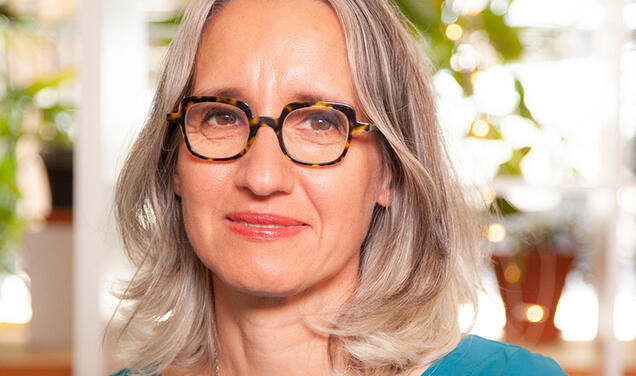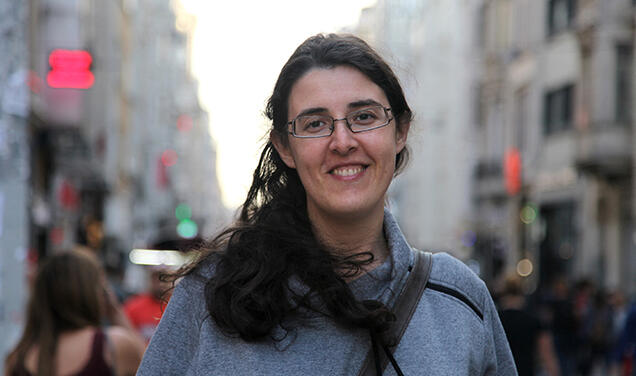
Like most of us, Katherine Milkman ’04 lives in a world of “shoulds” and “wants.” She should be content with a delicious and healthy spinach salad for lunch, but she wants to pick up a fried-chicken sandwich with a side of chips instead. She should be checking out the prize-winning documentary that everyone’s been talking about, but she wants to binge on lowbrow TV dramas. She should be writing a draft of her next academic paper, but she wants to catch up on her favorite news sites online.
For Milkman, an associate professor of operations, information, and decisions at the University of Pennsylvania’s Wharton School, knowing that these conflicts exist is not enough. She studies our behaviors scientifically — and devises clever ways to help bring our “shoulds” and “wants” into balance.
In 2014, Milkman published a study of a self-control strategy she calls “temptation bundling.” The idea is to link a want (in the study, listening to audio versions of page-turners such as the Hunger Games books) with a popular should (working out at the campus fitness center). If getting on a treadmill were the only way to hear the next chapter in the novel, would you be more likely to get off the couch and go to the gym?
The results were promising: Participants who had access to the audiobooks only at the gym made 51 percent more gym visits than those in the control group. (Another cohort that was encouraged, but not required, to restrict their listening to workout times had 29 percent more visits than the control group.)
The study falls under the broad umbrella of behavioral science, a field that gained influence when Princeton professor Daniel Kahneman — a psychologist known for exploring decision-making and behavior that contradicts economic theory — and George Mason University professor Vernon Smith shared the 2002 Nobel Prize in economics. Today’s behavioral scientists stand on the shoulders of giants such as Kahneman; his late collaborator Amos Tversky, who taught at Stanford; and Richard Thaler, a University of Chicago economist who has been a pioneer both in research and in explaining key findings to audiences outside academia. A string of best-selling books has shown the field’s popularity beyond the ivory tower.
When Milkman explained the temptation-bundling study and other research on the Freakonomics Radio podcast last year (listen to the show here), it struck a chord with listeners: Hundreds sent emails, sharing examples of their own “bundles.” While most involved household chores or exercise, some included more serious problems such as bouts with depression. Hearing how her ideas had the potential to influence people’s lives “was really nice,” Milkman says, “but it was a little overwhelming.”
Social scientists often mine personal experience for research questions, and those in Milkman’s field are particularly active observers. “One of my friends dubbed what we do ‘me-search’ because we sort of introspect or observe something funky that we’re actually fundamentally curious about,” she says, joking that it’s a productive way to be self-absorbed.
But “me-search” doesn’t work unless it’s “we-search” — that is, if it reveals a generalizable behavior, not some curious quirk. And the best of these explorations are paired with practical ways to give people a choice to alter that behavior — what Thaler and fellow economist Cass Sunstein have dubbed a “nudge” (which is also the title of their popular 2008 book on improving decisions).
John Beshears, an assistant professor at Harvard Business School and one of Milkman’s frequent co-authors, says she excels at bridging the space between the academic world of decision-making research and the scientifically curious public.
“She’s able to find these ideas that are conceptually novel and interesting — temptation bundling, from a purely conceptual standpoint, is brilliant,” he says. “But then simultaneously, [the ideas translate] into something that is quite practical and quite usable in the real world.”
Last spring, in one of the classrooms on the lower level of Robertson Hall, Milkman lectured to a group of Woodrow Wilson School graduate students who were studying the connections between psychology and policy implementation. It was a lively, curious group, particularly during the breaks that Milkman set aside for brainstorming. She asked the students to think of “commitment devices,” voluntarily imposed restrictions (or penalties) that help people accomplish a goal, and a loud hum of conversation immediately filled the room.
The ideas that the students shared didn’t sound revolutionary — a toothbrush that notifies your friends via Twitter if it wasn’t used before bedtime, or a blogging platform in which readers hold the authors accountable for posting regularly — but the discussions showed that the seeds of a certain mode of thinking were present in the future policymakers.
Milkman had a similar start in the behavioral sciences as a graduate student at Harvard, where she was part of an interdisciplinary program in computer science and the Harvard Business School. Sitting in a behavioral economics seminar next to Beshears, whom she’d just met, she would whisper ideas sparked by the day’s lecture. Some of those ideas eventually evolved into research projects or field experiments. “When she gets interested in or fascinated by an idea, she really wants to wrestle it to the ground,” Beshears says.
Max Bazerman, a Harvard Business School professor who advised Milkman’s doctoral dissertation and had written studies about the “want self” and “should self” that inspired her work, sees Milkman, Beshears, and others in their generation as innovators in behavioral science, creating “new opportunities for data that inform the world about social science in contemporary society.”
As a graduate student, Milkman was curious about the stories that tended to rise to the top of the “most emailed articles” list on the New York Times website. Using a web crawler that visited the Times site every 15 minutes, Milkman and collaborator Jonah Berger collected data on the articles featured on the home page and the frequently changing list. In a span of three months, they amassed data on nearly 7,000 articles that then were coded for content characteristics.
Berger and Milkman found that certain variables were predictors of high sharing rates — articles that were positive, emotional, and awe-inspiring, for instance. Other researchers frequently cite the study, which was an early example of academics exploring “virality” online.
Another project, led by Milkman and Beshears, studied the effect that “prompts” (in this case, written reminders) could have in encouraging employees to get flu shots. In a large experiment that included more than 3,200 employees of a Midwestern utility firm, they found that a simple change to the mailer announcing the company’s flu-shot clinic — adding a set of boxes in which people could jot down the date and time they intended to go — significantly helped their follow-through in getting the shot (a 4.2 percent increase versus the control group). The White House’s new Social and Behavioral Sciences Team and the Department of Health and Human Services (HHS) used the study as a blueprint in a 2015 project that aimed to increase health-insurance enrollment. Each of eight different letters used in the HHS experiment increased enrollment-completion rates, with the most successful one boosting enrollment by more than 13 percent.
Though Milkman works in the space between economics and psychology, as an undergraduate at Princeton, she did not major in either one. She had envisioned economics as a promising path, but her first course, introductory microeconomics with future Nobel laureate Paul Krugman, proved to be a rocky start. “The assumptions that the field seemed to rest on were all, to my mind, totally wrong — that people are perfect, optimizing machines,” she says.
Instead, Milkman gravitated to operations research and financial engineering (ORFE), where the assumptions (such as the distance between factories or the cost of fuel for trucks) seemed less open to debate. Professor emeritus Erhan Cinlar, the ORFE department chair at the time, remembers Milkman as a leader among her peers. When her study group had a question for the professor, she was the first one through the door at office hours. She also started the Princeton Operations Research Society, a student-run group that continues to host events for undergrads (including a webinar featuring Milkman last spring). “That kind of a student makes a difference in a department,” Cinlar says.
ORFE grads have a variety of career options in business, consulting, finance, and a range of academic disciplines. Milkman’s direction was unclear until she began working on her senior thesis. Inspired by a lecture by her English professor, Elaine Showalter, Milkman decided to use data to explore a common assumption in literature: that the characters in works of fiction often resemble the authors who created them.
At the time, says English professor William Gleason, one of Milkman’s thesis advisers, computational analysis in literary studies was just emerging as a prominent area of study. Milkman selected The New Yorker as her testing ground, reading and cataloging dozens of demographic characteristics for nearly 450 short stories published in a 10-year period. In pre-digital days, this meant leafing through red leather-bound compilations in Firestone Library — an experience she recalls with a nostalgic grin.
Her findings were intriguing, if not exactly shocking. Male authors typically wrote about male protagonists, and women wrote about women. The same was true for writing about lead characters from one’s own race or home country. But the data told an additional story: Women and members of minority groups were much more likely to write about protagonists outside their gender or race than the white male writers who produced a majority of New Yorker fiction pieces. Milkman also explored the varied choices made by different New Yorker editors about which stories to publish — a topic that drew interest from The New York Times, which published a story about Milkman’s thesis on the morning of her graduation from Princeton.
“I think in the best research projects, you’re in love with all parts of them,” says Milkman, who credits the thesis with nudging her toward a career in academia. “You desperately want to know the answers, but the journey to find them is also really interesting and fun.”
As a behavioral scientist, Milkman often has done research that highlights relatable behaviors — for example, the “fresh start” effect, in which she showed that people are more likely to stick with their “should” behaviors at the start of a new cycle, like the start of a week or month; or how being prepared for failure (i.e., having a backup plan) can be harmful when pursuing a goal.
She also has explored more hotly debated subjects. One of her most controversial studies looked at race and gender bias, asking whether professors discriminate against prospective students in the same ways that companies have been found to discriminate against job applicants. This wasn’t “me-search,” in a strict sense: Milkman says that her experiences with advisers and professors have been overwhelmingly positive. But looking at the demographics of her computer science classes at Harvard did make her wonder if discrimination was partly responsible for the underrepresentation of women and minority students.
Milkman and co-authors Modupe Akinola and Dolly Chugh designed an “audit” experiment. The common method would be to send résumés to employers with the same qualifications but different names that signal the applicant’s race or ethnicity and gender, but Milkman’s team was interested in professors, not human resources departments, so they sent personal emails instead of résumés. In the email, a student asked to schedule a 10-minute meeting to discuss research opportunities.
There also was a time-horizon element: Studies have shown that when making a decision for today, people often make impulsive choices, but when choosing for some later date — a week from today — people make more farsighted choices (the “should” of the want/should pair). Milkman wondered if professors would be less biased when the student requested a meeting in the more distant future.
Contacting more than 6,500 faculty members across the country was a massive undertaking. Sending the emails was automated, but the replies were handled in real time in two “war rooms,” at Wharton and Columbia Business School, where Akinola is a professor. From an ethical standpoint, Milkman says, it was important to minimize the inconvenience that the professors would experience by agreeing to meet with a fictional student. The war rooms ensured that each professor received a cancellation message within five minutes.
The good news, Milkman says, is that professors showed “unbelievable generosity” to students who were essentially cold-calling them. Nearly 70 percent responded, mostly in the affirmative.
The bad news, from the perspective of a young professor who deeply admires those in her profession: Professors tended to discriminate, failing to respond to meeting requests from Asian-American, black, and Hispanic students at higher rates than requests from white students. The study also found some discrimination against women, though it was not as pronounced as the racial bias. And Milkman’s time hypothesis — that professors might be less likely to discriminate based on race or gender when making a more farsighted decision — did not materialize.
Discrimination appeared across the board, in disciplines with diverse faculty representation and those that are less diverse. Reaching out to a faculty member of the same race or gender did not seem to make a difference either, with the exception of Chinese students writing to Chinese professors. (Overall, Chinese students faced more discrimination than any other demographic group.)
Milkman and her colleagues published their results in two papers, in 2012 and 2014, and also reported the findings in a New York Times Sunday Review article. Though the magnitude of discrimination by professors was comparable to that in the literature for corporate workplaces — not significantly better or worse — some readers from the academy took offense at the scrutiny, sending critical (and in some cases hostile) letters and emails.
In hindsight, Milkman says she understands the blowback. The relationships in academia “make this career worth having,” she says; no one can do it alone, and your mentors and collaborators feel like a second family. So the realization that professors may be keeping people out of their families due to race and gender, consciously or not, was a painful idea to some.
“I’d do it again,” Milkman says of the study, “but I have empathy for the people who are angry.”
Race and gender continue to play a part in Milkman’s work. One topic on her mind is the composition of corporate boards. (She’s stepped away from studying academia, for now.) But behavioral topics dominate her research agenda: improving decisions, balancing wants and shoulds, and forming positive habits, an area she finds particularly promising.
“A lot of the work in my field, including my own, looks at one-off solutions: How can I change your behavior on this one day, in this one moment?” she says. That can be meaningful in the long term when the decision is, say, enrolling in a 401(k) plan. But many of the things we struggle with — and which influence our lifelong well-being — are repeated decisions, made on a daily basis.
WATCH a video of Milkman explaining temptation bundling, using 30 Rock’s Liz Lemon
With her University of Pennsylvania colleague Angela Duckworth, the author of the New York Times best-seller Grit: The Power of Passion and Perseverance, Milkman is working to develop a multifaceted project aimed at “making behavior change stick.” Their proposal was selected as the university’s submission for a $100 million MacArthur Foundation grant competition.
Can behavioral science be used to change habits in the longer run? How would it work? Which decisions are the best candidates for everyday “nudging”? For Milkman, there are plenty of intriguing questions to explore — and audiences anxious to hear the answers.
“It’s hard to study — you have to collect data over a long time horizon,” she says. “We don’t know as much about it. I think we’ve only scratched the surface.”
Brett Tomlinson is PAW’s digital editor and sports editor.





2 Responses
Max Maizels ’72
8 Years AgoA Striking Similarity
The alumna pictured on the Oct. 26 cover [Katherine Milkman ’04] has such an uncanny doppelgänger resemblance to a White House-era Chelsea Clinton that it makes me wonder if they are somehow related.
Adena Spingarn ’03
8 Years AgoUndermining Women
After reading about Katherine Milkman ’04’s fascinating research in the Oct. 26 issue, why on Earth would Max Maizels ’72 decide to comment on her appearance (Inbox, Dec. 7)? And why would PAW print such a letter? Comments like Maizels’ undermine women by implying that no matter how much we accomplish intellectually, our appearance is all that really matters. More than half a century after women entered Princeton, we deserve better.